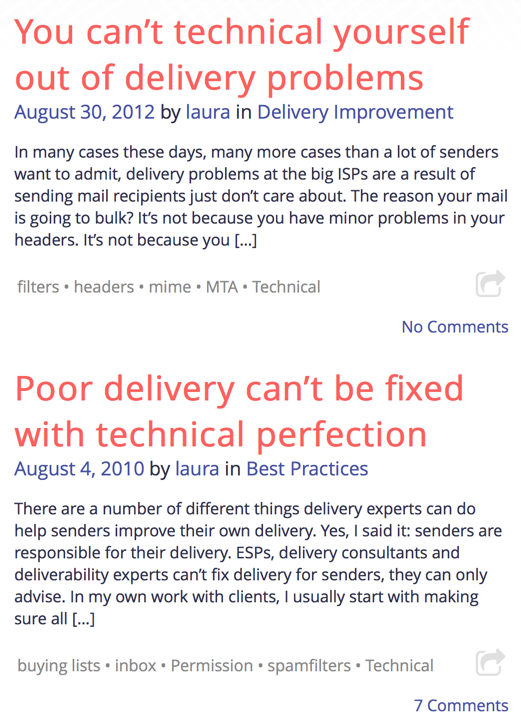Recent Posts
Phone call of the week
- laura
- May 5, 2016
I  received a message on our 800 number. “This is Mark from a-website.example. Your customers are complaining to me that they are not getting my mail. And you’re blocking mail from me. Explain this to me!”
received a message on our 800 number. “This is Mark from a-website.example. Your customers are complaining to me that they are not getting my mail. And you’re blocking mail from me. Explain this to me!”
I called him back and left a message: “I think you’re confused and I probably can’t help you.”
A few minutes later, Mark returns my call.
L: Hi, this is laura.
M: Who are you? You called me, you must be from Clearwire!
L: No, I’m not with Clearwire, I’m with WttW.
M: Then why is your phone number on the Clearwire website?
L: I don’t know, but this isn’t Clearwire. The Clearwire website is redirecting to Sprint. They got bought out a while ago.
M: Redirecting to Sprint? What does that mean? Your phone number is on Clearwire’s website. You must be with Clearwire.
L: No, really, I’m not.
M: Why is your phone number on their website?
L: I don’t know. But this is not Clearwire. (I start searching the blog because I remember some post somewhere about Clearwire.)
M: Well, who are you?
L: I run a delivery consulting firm. Is it possible you found my website and the blog post that says all clearwire.net addresses are being discontinued April 15, 2015?
M: They’re gone?
L: Yes, for more than a year now.
M: Oh.
scene
That blog post is the #1 google hit if you search for clearwire.net.
Changes coming to Verizon email
- laura
- May 4, 2016
Last year Verizon bought AOL. As part of that merger some @verizon.net email is being migrated to the AOL backend. FAQs published by Verizon say this change is only affecting users in FL, TX and CA. Users will still have @verizon.net addresses but the backend and filtering will be managed by AOL.
This shouldn’t have a huge impact on commercial senders. However, one thing I did notice while reading through the FAQ is this:
April 2016: The Month in Email
- laura
- May 3, 2016
We are finishing up another busy month at WttW. April was a little nutty with network glitches, server crashes, cat woes, and other disruptions, but hopefully that’s all behind us as we head into May. I’ll be very busy in May as well, speaking at Salesforce Connections in Atlanta and the Email Innovation Summit in Las Vegas. Please come say hello if you’re attending either of these great events.
Speaking of great events, I participated in two panels at EEC16 last month. We had a lot of great audience participation, and I met many wonderful colleagues. I wrote up some more thoughts about the conference here. I also had a nice conversation with the folks over at Podbox, and they’ve posted my interview on their site.
In the Podbox interview, as always, I talked about sending mail people want to receive. It always makes me roll my eyes a bit when I see articles with titles like “5 Simple Ways to Reach the Inbox”, so I wrote a bit about that here. In addition to sending mail people want to receive, senders need to make sure they are collecting addresses and building lists in thoughtful and sustainable ways. For more on this topic, check out my post on list brokers and purchased lists.
These same not-so-simple tricks came up again in my discussion of Gmail filters. Everyone wants a magic formula to reach the inbox, and — sorry to burst your bubble — there isn’t ever going to be one. And this is for a good reason: a healthy filter ecosystem helps protect all of us from malicious senders and criminal activity. The email channel is particularly vulnerable to fraud and theft. The constant evolution of filters is one way mail providers can help protect both senders and recipients — but it can be challenging for senders and systems administrators to keep up with this constant evolution. For example, companies sometimes even inadvertently filter their own mail!
I also wrote a bit about how B2B spam is different from B2C spam, and how marketers can better comply with CAN SPAM guidelines in order to reach the inbox. We also republished our much-missed friend and colleague J.D. Falk’s DKIM Primer, which is extremely useful information that was at a no-longer-active link.
One of my favorite posts this month was about “dueling data”, and how to interpret seemingly different findings around email engagement. We also got some good questions for my “Ask Laura” column, where we cover general topics on email delivery. This month we looked at “no auth/no entry” and the Microsoft Smartscreen filter, both of which are useful things to understand for optimizing delivery.
Finally, we are pleased to announce that we’ve joined the i2Coalition, an organization of internet infrastructure providers. They posted a nice introduction on their blog, and we look forward to working with them to help advocate and protect these important technical infrastructures.
Pete and Repeat
- laura
- May 2, 2016
Pete and Repeat were on a boat. Pete fell out, who was left?
I was searching the blog for some resources today and these were the first two posts that showed up on the search results. I often feel like I’m repeating myself, but sometimes I am.
Trust the list broker
- laura
- Apr 29, 2016
Over the years I’ve worked with companies who admit to me that they’ve purchased data at one point or another. Let’s face it, as bad a practice as it is, people and companies still think they can succeed in email marketing with purchased lists.
As part of the cleanup process, I start to ask questions about the list. Who did you buy it from? How were the addressees collected? Are these addresses shared with others? What did the seller tell you about the list.
Clients are rarely able to tell me about where the addresses are collected or if they’re shared.
It’s amazing to me how many companies choose to outsource the creation of such a valuable asset. They don’t know anything about it, but it’s a huge asset and so important they won’t let go when it doesn’t work.
Some of it is the sunk cost fallacy. But I think in some cases my clients don’t really believe the person who sold them the list wasn’t truthful. They really believe there is value in the list, if they can only unlock it.
Companies selling lists don’t really have any incentive to spend time or money making sure they have permission or that the lists are good. That’s just expense to them and returns no value. The value is in the number of addresses they can sell, not in the number of responsive addresses.
How many companies buy a list and immediately take it to a list cleansing service? Why should they? Shouldn’t the company SELLING the list make sure they’re selling deliverable addresses? Shouldn’t the seller spend the money for verification?
The very fact that so many companies believe they need to clean a purchased list speaks to the horrible quality of purchased lists. And, yet, companies are addicted to the idea of purchasing lists. They trust that the addresses are collected in a permission based manner. They believe when sellers tell them the addresses are good and valid – even when they see that 10 or 20 or 30% of the list is cleaned off by the list services.
List sellers won’t do the cleaning because they know they’re not providing the product. It’s a con and it’s a swindle and yet marketers still think they’re getting something of value from list sellers. And they still discover purchased lists are horrible in terms of deliverability and performance.
Let's talk CAN SPAM
- laura
- Apr 29, 2016
 Earlier this week I posted about the increased amount of B2B spam I’m receiving. One message is not a huge deal and I just delete and move on. But many folks are using marketing automation to send a series of emails. These emails often violate CAN SPAM in one way or another.
Earlier this week I posted about the increased amount of B2B spam I’m receiving. One message is not a huge deal and I just delete and move on. But many folks are using marketing automation to send a series of emails. These emails often violate CAN SPAM in one way or another.
This has been the law for 13 years now, I find it difficult to believe marketers are still unaware of what it says. But, for the sake of argument, let’s talk about CAN SPAM.
We joined the i2Coalition
- laura
- Apr 27, 2016
Word to the Wise has joined the i2Coalition. Today they posted our introduction to their blog.
Why did we do it?
Email, and online spaces, are so important to modern life. We shop, bank, communicate, play and interact online. The internet has facilitated everything from political revolution to coffee dates and international friendships. Steve watched the Berlin Wall fall from his college dorm room over the internet. The internet was a major factor in the organization of the Arab Spring and other political movements. And sometimes we just meet people online. BBSes, usenet, email, and social networks let us connect with each other.
With that being said, too many people see online spaces as nebulous and “not real.” But the reality is that people genuinely connect, organize, and participate in online spaces. Those spaces need to be protected so these things can continue. The internet is, in many ways, a very special and unique place that has facilitated the growth of millions of communities. Unless we protect the infrastructure, these communities will fall apart and be useless.
It's still spam
- laura
- Apr 26, 2016
Companies are always trying to find new ways to use and abuse email. My mailbox has been rife with mail from companies trying to sell me stuff for my business. It’s been interesting to watch the new ways they’re trying to get attention, while not honoring the most important rule of email marketing.
The source of deliverability problems
- laura
- Apr 25, 2016
Most deliverability problems don’t start where many people think they do. So very often people call looking for deliverability help and tell me all about the things they’re doing to reach the inbox. They’ll tell me about content, they’ll tell me about bounces, they’ll talk about complaints, engagement, opens and clicks. Rarely will they bring up their list source without some prompting on my part.
The reality is, though, that list source is to root of deliverability success and deliverability problems. Where did those addresses come from and what do the people who gave them think you’re going to do with them?
Outsourcing collection to a third party can cause significant issues with delivery. Letting other people collect addresses on your behalf means you lack control over the process. And if you’re paying per address, then there monetary incentive for that company to pad the list with bogus addresses.
Sometimes there are even issues with having your own employees collect addresses from customers. For instance, a retailer requires sales associates collect a minimum percentage of addresses from customers. The company even ties the associates’ evaluations to that percentage. Associates have an incentive to submit addresses from other customers. Or a retailer will offer a discount for an address and customers want the discount but not the mail, so they give a fake address.
All of these things can affect deliverability.
Address collection is the key to delivery, but too many companies just don’t put enough attention to how they’re collecting addresses and entering into the relationship with subscribers. This is OK for a while, and delivery of small lists collected like this can be great. But as lists grow in size, they come under greater scrutiny at the ISPs and what used to work doesn’t anymore.
The first step to diagnosing any delivery problem is to look at the list. All of the things ISP use to measure reputation measure how well you’re collecting addresses. Changing IPs or domains or content doesn’t change the reason mail is being filtered. It just means the filters have to figure out something new to key on.
Want great deliverability? Start with how you’re collecting addresses.
Want to fix deliverability? Start with how you’ve collected addresses, how you’ve stored them and how you’ve maintained them.
Categories
Tags
- 2010
- 2016
- 2fa
- 419
- 4xx
- 554
- 5xx
- @
- Aarp
- Abacus
- Abandoned
- Aboutmyemail
- Abuse
- Abuse Desk
- Abuse Enforcement
- Abuse Prevention
- Academia
- Accreditation
- Acme
- Acquisition
- Address Book
- Addresses
- Administrivia
- Adsp
- Advanced Delivery
- Advertiser
- Advertising
- Advice
- Affiliate
- Affiliates
- After the Email
- Alerts
- Algorithm
- Alice
- Alignment
- Allcaps
- Alt Text
- AMA
- Amazon
- Amp
- Amsterdam
- Analysis
- Anecdotes
- Anti-Spam
- Anti-Spam Laws
- Anti-Spammers
- Antwort
- AOL
- Appeals
- Appearances
- Appending
- Apple
- Arc
- Arf
- Arrest
- Arrests
- Ascii
- Asides
- Ask Laura
- Askwttw
- Assertion
- Assumptions
- ATT
- Attacks
- Attention
- Attrition
- Audit
- Authentication
- Authentication. BT
- Autonomous
- Award
- B2B
- B2C
- Backhoe
- Backscatter
- Banks
- Barracuda
- Barry
- Base64
- Base85
- Bcp
- Bear
- Bears
- Behaviour
- Benchmark
- BESS
- Best Practices
- Bgp
- Bimi
- Bit Rot
- Bitly
- Bizanga
- Black Friday
- Blackfriday
- Blacklist
- Blacklists
- Blast
- Blo
- Block
- Blockin
- Blocking
- Blocklist
- Blocklisting
- Blocklists
- Blocks
- Blog
- Blog Links
- Blogroll
- Blogs
- Bob
- Boca
- Bofa
- Book Review
- Bot
- Botnet
- Botnets
- Bots
- Bounce
- Bounce Handling
- Bounces
- Branding
- Brands
- Breach
- Breaches
- Breech
- Bronto
- Browser
- Bsi
- Bucket
- Bulk
- Bulk Folder
- Bulk Mail
- Business
- Business Filters
- Buying Leads
- Buying Lists
- C-28
- CA
- Caa
- Cabbage
- Cache
- Cadence
- CAH
- California
- Campaign
- CAN SPAM
- Canada
- Candy
- Candycandycandy
- Canonicalization
- Canspam
- Captcha
- Career Developmnent
- Careers at WttW
- Cargo Cult
- Case Law
- Cases
- CASL
- Cat
- Cbl
- CDA
- Cert
- Certification
- CFL
- Change
- Charter
- Cheat
- Cheese
- Choicepoint
- Choochoo
- Christmas
- Chrome
- Cidr
- Cisco
- Civil
- Clear.net
- Clearwire.net
- Cli
- Click
- Click Through
- Click Tracking
- Clicks
- Clickthrough
- Client
- Cloudflare
- Cloudmark
- Cname
- Co-Reg
- Co-Registration
- Cocktail
- Code
- COI
- Comcast
- Comments
- Commercial
- Communication
- Community
- Comodo
- Comparison
- Competitor
- Complaint
- Complaint Rates
- Complaints
- Compliancce
- Compliance
- Compromise
- Conference
- Conferences
- Confirmation
- Confirmed (Double) Opt-In
- Confirmed Opt-In
- Congress
- Consent
- Conservatives
- Consistency
- Constant Contact
- Consultants
- Consulting
- Content
- Content Filters
- Contracts
- Cookie
- Cookie Monster
- COPL
- Corporate
- Cost
- Court Ruling
- Cox
- Cox.net
- Cpanel
- Crib
- Crime
- CRM
- Crowdsource
- Crtc
- Cryptography
- CS&M
- CSRIC
- CSS
- Curl
- Customer
- Cyber Monday
- Czar
- Data
- Data Hygiene
- Data Security
- Data Segmentation
- Data Verification
- DBL
- Dbp
- Ddos
- Dea
- Dead Addresses
- Dedicated
- Dedicated IPs
- Defamation
- Deferral
- Definitions
- Delays
- Delisting
- Deliverability
- Deliverability Experts
- Deliverability Improvement
- Deliverability Summit
- Deliverability Week
- Deliverability Week 2024
- Deliverabiltiy
- DeliverabiltyWeek
- Delivery Blog Carnival
- Delivery Discussion
- Delivery Emergency
- Delivery Experts
- Delivery Improvement
- Delivery Lore
- Delivery News
- Delivery Problems
- Dell
- Design
- Desks
- Dhs
- Diagnosis
- Diff
- Dig
- Direct Mag
- Direct Mail
- Directives
- Discounts
- Discovery
- Discussion Question
- Disposable
- Dk
- DKIM
- Dkimcore
- DMA
- Dmarc
- Dns
- Dnsbl
- Dnssec
- Docs
- Doingitright
- Domain
- Domain Keys
- Domain Reputation
- DomainKeys
- Domains
- Domains by Proxy
- Dontpanic
- Dot Stuffing
- Dotcom
- Double Opt-In
- Dublin
- Dyn
- Dynamic Email
- E360
- Earthlink
- Ec2
- Ecoa
- Economics
- ECPA
- Edatasource
- Edns0
- Eec
- Efail
- Efax
- Eff
- Election
- Email Address
- Email Addresses
- Email Change of Address
- Email Client
- Email Design
- Email Formats
- Email Marketing
- Email Verification
- Emailappenders
- Emailgeeks
- Emails
- Emailstuff
- Emoji
- Emoticon
- Encert
- Encryption
- End User
- Endusers
- Enforcement
- Engagement
- Enhanced Status Code
- Ennui
- Entrust
- Eol
- EOP
- Epsilon
- Esp
- ESPC
- ESPs
- EU
- Ev Ssl
- Evaluating
- Events
- EWL
- Exchange
- Excite
- Expectations
- Experience
- Expires
- Expiring
- False Positives
- FAQ
- Fathers Day
- Fbl
- FBL Microsoft
- FBLs
- Fbox
- FCC
- Fcrdns
- Featured
- Fedex
- Feds
- Feedback
- Feedback Loop
- Feedback Loops
- Fiction
- Filter
- Filter Evasion
- Filtering
- Filterings
- Filters
- Fingerprinting
- Firefox3
- First Amendment
- FISA
- Flag Day
- Forensics
- Format
- Formatting
- Forms
- Forwarding
- Fraud
- Freddy
- Frequency
- Friday
- Friday Spam
- Friendly From
- From
- From Address
- FTC
- Fussp
- Gabbard
- Gdpr
- Geoip
- Gevalia
- Gfi
- Git
- Giveaway
- Giving Up
- Global Delivery
- Glossary
- Glyph
- Gmail
- Gmails
- Go
- Godaddy
- Godzilla
- Good Email Practices
- Good Emails in the Wild
- Goodmail
- Google Buzz
- Google Postmaster Tools
- Graphic
- GreenArrow
- Greylisting
- Greymail
- Groupon
- GT&U
- Guarantee
- Guest Post
- Guide
- Habeas
- Hack
- Hacking
- Hacks
- Hall of Shame
- Harassment
- Hard Bounce
- Harvesting
- Harvey
- Hash
- Hashbusters
- Headers
- Heartbleed
- Hearts
- HELO
- Help
- Henet
- Highspeedinternet
- Hijack
- History
- Holiday
- Holidays
- Holomaxx
- Hostdns4u
- Hostile
- Hostname
- Hotmail
- How To
- Howto
- Hrc
- Hsts
- HTML
- HTML Email
- Http
- Huey
- Humanity
- Humor
- Humour
- Hygiene
- Hypertouch
- I18n
- ICANN
- Icloud
- IContact
- Identity
- Idiots
- Idn
- Ietf
- Image Blocking
- Images
- Imap
- Inbox
- Inbox Delivery
- Inboxing
- Index
- India
- Indiegogo
- Industry
- Infection
- Infographic
- Information
- Inky
- Inline
- Innovation
- Insight2015
- Integration
- Internationalization
- Internet
- Intuit
- IP
- IP Address
- Ip Addresses
- IP Repuation
- IP Reputation
- IPhone
- IPO
- Ipv4
- Ipv6
- Ironport
- Ironport Cisco
- ISIPP
- ISP
- ISPs
- J.D. Falk Award
- Jail
- Jaynes
- JD
- Jobs
- Json
- Junk
- Juno/Netzero/UOL
- Key Rotation
- Keybase
- Keynote
- Kickstarter
- Kraft
- Laposte
- Lavabit
- Law
- Laws
- Lawsuit
- Lawsuits
- Lawyer
- Layout
- Lead Gen
- Leak
- Leaking
- Leaks
- Legal
- Legality
- Legitimate Email Marketer
- Letsencrypt
- Letstalk
- Linked In
- Links
- List Hygiene
- List Management
- List Purchases
- List the World
- List Usage
- List-Unsubscribe
- Listing
- Listmus
- Lists
- Litmus
- Live
- Livingsocial
- London
- Lookup
- Lorem Ipsum
- Lycos
- Lyris
- M3AAWG
- Maawg
- MAAWG2007
- Maawg2008
- MAAWG2012
- MAAWGSF
- Machine Learning
- Magill
- Magilla
- Mail Chimp
- Mail Client
- MAIL FROM
- Mail Privacy Protection
- Mail Problems
- Mail.app
- Mail.ru
- Mailboxes
- Mailchimp
- Mailgun
- Mailing Lists
- Mailman
- Mailop
- Mainsleaze
- Maitai
- Malicious
- Malicious Mail
- Malware
- Mandrill
- Maps
- Marketer
- Marketers
- Marketing
- Marketo
- Markters
- Maths
- Mcafee
- Mccain
- Me@privacy.net
- Measurements
- Media
- Meh
- Meltdown
- Meme
- Mentor
- Merry
- Messagelabs
- MessageSystems
- Meta
- Metric
- Metrics
- Micdrop
- Microsoft
- Milter
- Mime
- Minimal
- Minshare
- Minute
- Mit
- Mitm
- Mobile
- Models
- Monitoring
- Monkey
- Monthly Review
- Mpp
- MSN/Hotmail
- MSN/Hotmail
- MTA
- Mua
- Mutt
- Mx
- Myths
- Myvzw
- Netcat
- Netsol
- Netsuite
- Network
- Networking
- New Year
- News
- News Articles
- Nhi
- NJABL
- Now Hiring
- NTP
- Nxdomain
- Oath
- Obituary
- Office 365
- Office365
- One-Click
- Only Influencers
- Oops
- Opaque Cookie
- Open
- Open Detection
- Open Rate
- Open Rates
- Open Relay
- Open Tracking
- Opendkim
- Opens
- Openssl
- Opt-In
- Opt-Out
- Optonline
- Oracle
- Outage
- Outages
- Outblaze
- Outlook
- Outlook.com
- Outrage
- Outreach
- Outsource
- Ownership
- Owning the Channel
- P=reject
- Pacer
- Pander
- Panel
- Password
- Patent
- Paypal
- PBL
- Penkava
- Permission
- Personalities
- Personalization
- Personalized
- Pgp
- Phi
- Philosophy
- Phish
- Phishers
- Phishing
- Phising
- Photos
- Pii
- PIPA
- PivotalVeracity
- Pix
- Pluscachange
- Podcast
- Policies
- Policy
- Political Mail
- Political Spam
- Politics
- Porn
- Port25 Blocking
- Postfix
- Postmaster
- Power MTA
- Practices
- Predictions
- Preferences
- Prefetch
- Preview
- Primers
- Privacy
- Privacy Policy
- Privacy Protection
- Private Relay
- Productive Mail
- Promotions
- Promotions Tab
- Proofpoint
- Prospect
- Prospecting
- Protocols
- Proxy
- Psa
- PTR
- Public Suffix List
- Purchased
- Purchased Lists
- Purchases
- Purchasing Lists
- Questions
- Quoted Printable
- Rakuten
- Ralsky
- Rant
- Rate Limiting
- Ray Tomlinson
- Rc4
- RDNS
- Read
- Ready to Post
- Readytopost
- Real People
- Realtime Address Verification
- Recaptcha
- Received
- Receivers
- Recipient
- Recipients
- Redirect
- Redsnapper
- Reference
- Registrar
- Registration
- Rejection
- Rejections
- Rejective
- Relationship
- Relevance
- Relevancy
- Removals
- Render Rate
- Rendering
- Repost
- Repudiation
- Reputation
- Requirements
- Research
- Resources
- Responsive
- Responsive Design
- Responsys
- Retail
- Retired Domains
- Retro
- Return Path
- Return Path Certified
- ReturnPath
- Reunion.com
- Reverse Dns
- Rfc
- RFC2047
- RFC2821/2822
- RFC5321/5322
- RFC5322
- RFC8058
- RFC821/822
- RFCs
- Roadr
- RoadRunner
- Rodney Joffe
- ROKSO
- Role Accounts
- Rollout
- RPost
- RPZ
- Rule 34
- Rules
- Rum
- Rustock
- S.1618
- SaaS
- Sales
- Salesforce
- Sass
- SBCGlobal
- Sbl
- Scam
- Scammers
- Scams
- Scanning
- Scraping
- Screamer
- Screening
- Script
- Sec
- Secure
- Security
- Segmentation
- Selligent
- Send
- Sender
- Sender Score
- Sender Score Certified
- Senderbase
- Senderid
- Senders
- Senderscore
- Sendgrid
- Sending
- Sendy
- Seo
- Service
- Services
- Ses
- Seth Godin
- SFDC
- SFMAAWG2009
- SFMAAWG2010
- SFMAAWG2014
- Shared
- Shell
- Shouting
- Shovel
- Signing
- Signups
- Silly
- Single Opt-In
- Slack
- Slicing
- Smarthost
- Smiley
- Smime
- SMS
- SMTP
- Snds
- Snowshoe
- Soa
- Socia
- Social Media
- Social Networking
- Soft Bounce
- Software
- Sony
- SOPA
- Sorbs
- Spam
- Spam Blocking
- Spam Definition
- Spam Filtering
- Spam Filters
- Spam Folder
- Spam Law
- Spam Laws
- Spam Reports
- Spam Traps
- Spam. IMessage
- Spamarrest
- Spamassassin
- Spamblocking
- Spamcannibal
- Spamcon
- Spamcop
- Spamfiltering
- Spamfilters
- Spamfolder
- Spamhaus
- Spamhause
- Spammer
- Spammers
- Spammest
- Spamming
- Spamneverstops
- Spamresource
- Spamtrap
- Spamtraps
- Spamza
- Sparkpost
- Speaking
- Special Offers
- Spectre
- Spf
- Spoofing
- SproutDNS
- Ssl
- Standards
- Stanford
- Starttls
- Startup
- State Spam Laws
- Statistics
- Storm
- Strategy
- Stunt
- Subject
- Subject Lines
- Subscribe
- Subscriber
- Subscribers
- Subscription
- Subscription Process
- Success Stories
- Suing
- Suppression
- Surbl
- Sureclick
- Suretymail
- Survey
- Swaks
- Syle
- Symantec
- Tabbed Inbox
- Tabs
- Tagged
- Tagging
- Target
- Targeting
- Techincal
- Technical
- Telnet
- Template
- Tempo
- Temporary
- Temporary Failures
- Terminology
- Testing
- Text
- Thanks
- This Is Spam
- Throttling
- Time
- Timely
- TINS
- TLD
- Tlp
- TLS
- TMIE
- Tmobile
- Too Much Mail
- Tool
- Tools
- Toomuchemail
- Tor
- Trademark
- Traffic Light Protocol
- Tragedy of the Commons
- Transactional
- Transition
- Transparency
- Traps
- Travel
- Trend/MAPS
- Trend Micro
- Trend/MAPS
- Trigger
- Triggered
- Troubleshooting
- Trustedsource
- TWSD
- Txt
- Types of Email
- Typo
- Uce
- UCEprotect
- Unblocking
- Uncategorized
- Unexpected Email
- Unicode
- Unroll.me
- Unsolicited
- Unsubcribe
- Unsubscribe
- Unsubscribed
- Unsubscribes
- Unsubscribing
- Unsubscription
- Unwanted
- URIBL
- Url
- Url Shorteners
- Usenet
- User Education
- Utf8
- Valentine's Day
- Validation
- Validity
- Value
- Valueclick
- Verification
- Verizon
- Verizon Media
- VERP
- Verticalresponse
- Vetting
- Via
- Video
- Violence
- Virginia
- Virtumundo
- Virus
- Viruses
- Vmc
- Vocabulary
- Vodafone
- Volume
- Vzbv
- Wanted Mail
- Warmup
- Weasel
- Webinar
- Webmail
- Weekend Effect
- Welcome Emails
- White Space
- Whitelisting
- Whois
- Wiki
- Wildcard
- Wireless
- Wiretapping
- Wisewednesday
- Women of Email
- Woof
- Woot
- Wow
- Wtf
- Wttw in the Wild
- Xbl
- Xfinity
- Xkcd
- Yahoo
- Yahoogle
- Yogurt
- Zoidberg
- Zombie
- Zombies
- Zoominfo
- Zurb
